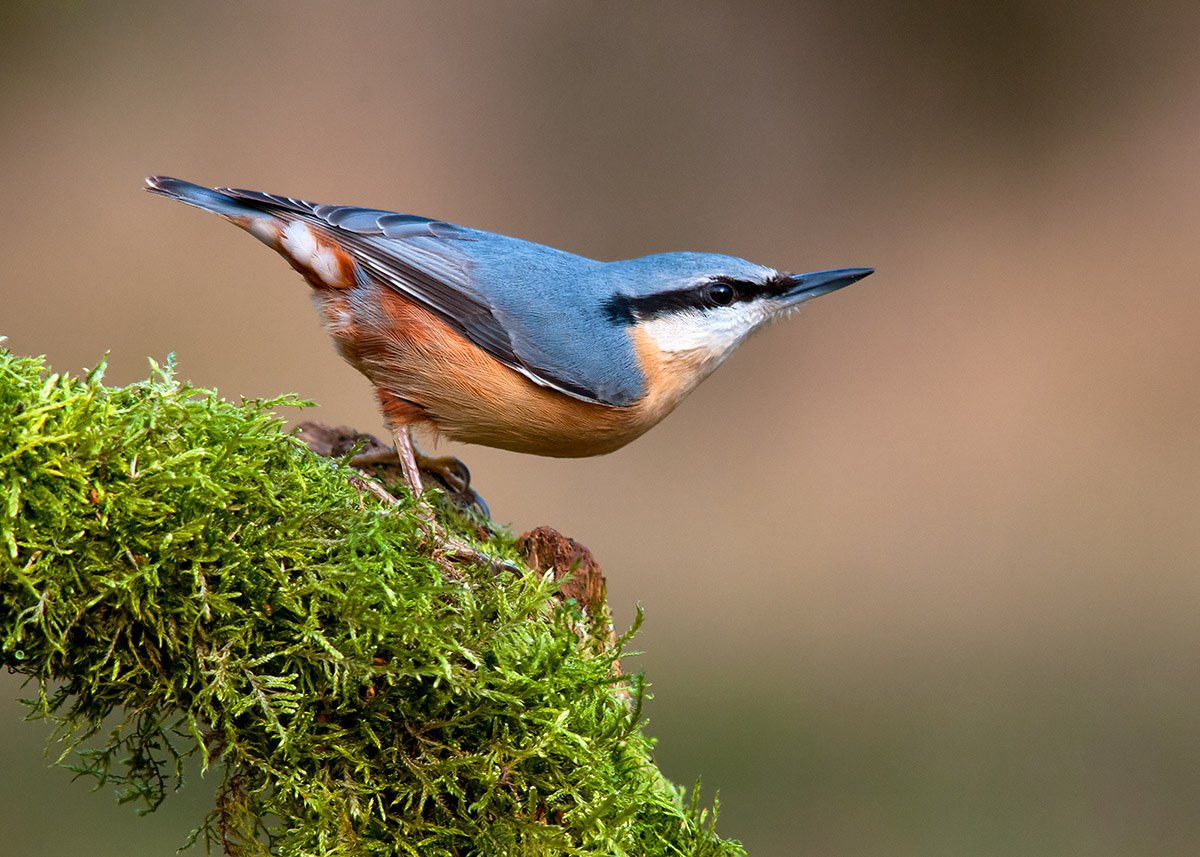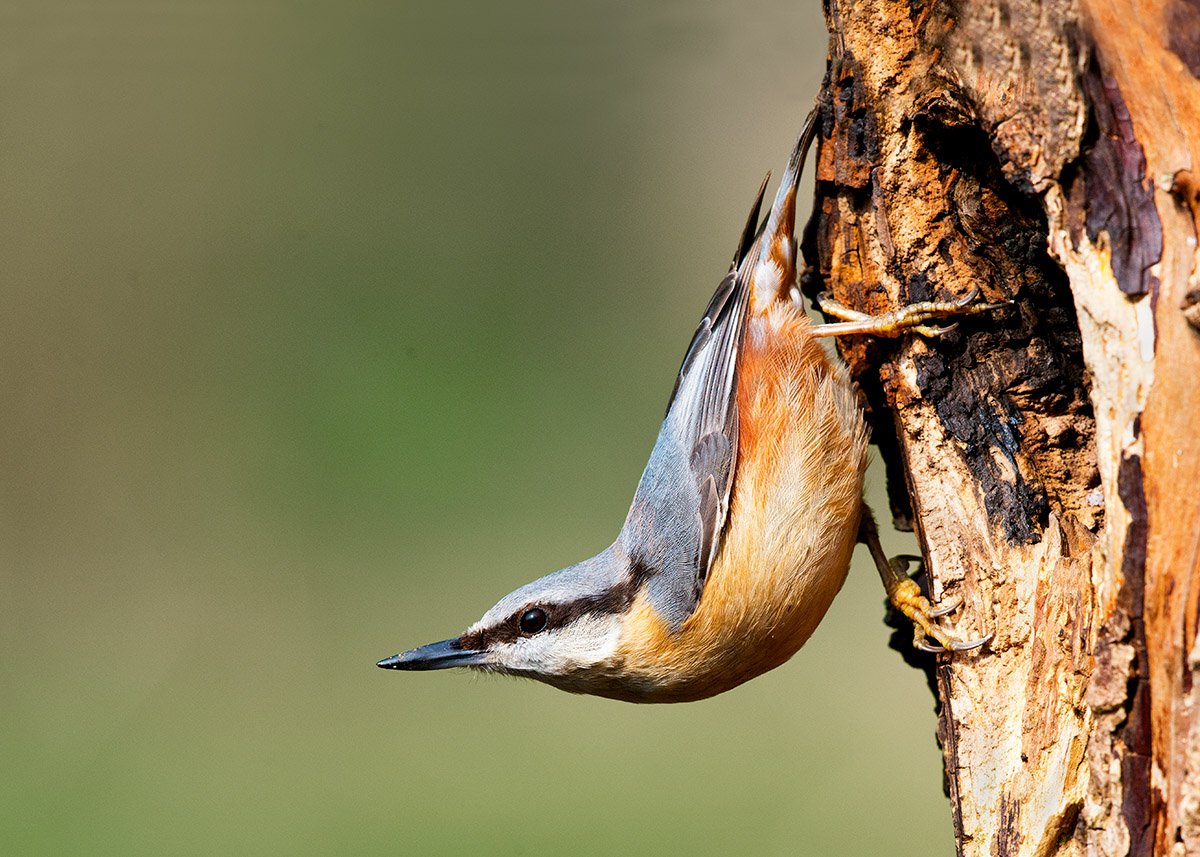 Image 1 of
Image 1 of


Nuthatch
The nuthatch is a charismatic and distinctive bird known for its unique behaviour and striking appearance. Here's an overview of this fascinating species:
Appearance: Nuthatches are small, compact birds with short tails and long, sturdy bills. They have blue-gray upperparts, a white face, and a chestnut-coloured belly. Their distinctive black eye stripe and white throat patch make them easily recognizable. Some species, such as the Eurasian nuthatch, have a black cap on their heads.
Habitat: Nuthatches are found in a variety of woodland habitats, including deciduous and mixed forests, as well as parks, gardens, and orchards with mature trees. They prefer habitats with plenty of trees for foraging and nesting, often favouring areas with dead wood for feeding.
Behaviour: Nuthatches are agile climbers and spend much of their time moving headfirst down tree trunks and branches in search of food. They have strong feet and sharp claws that allow them to cling to vertical surfaces with ease. Nuthatches are known for their habit of wedging seeds and nuts into crevices in bark and then hammering them open with their bills.
Diet: Nuthatches have a varied diet that includes insects, seeds, nuts, and berries. They use their strong bills to probe and pry open bark in search of insects and larvae, as well as to crack open seeds and nuts. Nuthatches are also known to visit bird feeders, where they may take sunflower seeds or peanuts.
Breeding: Breeding season for nuthatches typically occurs in spring and summer. They excavate nesting holes in dead or decaying trees, often using old woodpecker holes or natural cavities. The female lays a clutch of eggs, usually numbering between 5 to 9, which she incubates for around two weeks. Both parents share in the feeding and care of the young until they fledge.
Conservation: Nuthatches are widespread and common throughout much of their range, but they may face threats from habitat loss, particularly the loss of mature trees and woodland habitat. Conservation efforts focus on preserving and restoring suitable habitat, as well as providing nesting opportunities in parks, gardens, and urban areas.
Overall, the nuthatch's unique appearance, behaviour, and adaptability make it a beloved and cherished bird species among birdwatchers and nature enthusiasts.
The nuthatch is a charismatic and distinctive bird known for its unique behaviour and striking appearance. Here's an overview of this fascinating species:
Appearance: Nuthatches are small, compact birds with short tails and long, sturdy bills. They have blue-gray upperparts, a white face, and a chestnut-coloured belly. Their distinctive black eye stripe and white throat patch make them easily recognizable. Some species, such as the Eurasian nuthatch, have a black cap on their heads.
Habitat: Nuthatches are found in a variety of woodland habitats, including deciduous and mixed forests, as well as parks, gardens, and orchards with mature trees. They prefer habitats with plenty of trees for foraging and nesting, often favouring areas with dead wood for feeding.
Behaviour: Nuthatches are agile climbers and spend much of their time moving headfirst down tree trunks and branches in search of food. They have strong feet and sharp claws that allow them to cling to vertical surfaces with ease. Nuthatches are known for their habit of wedging seeds and nuts into crevices in bark and then hammering them open with their bills.
Diet: Nuthatches have a varied diet that includes insects, seeds, nuts, and berries. They use their strong bills to probe and pry open bark in search of insects and larvae, as well as to crack open seeds and nuts. Nuthatches are also known to visit bird feeders, where they may take sunflower seeds or peanuts.
Breeding: Breeding season for nuthatches typically occurs in spring and summer. They excavate nesting holes in dead or decaying trees, often using old woodpecker holes or natural cavities. The female lays a clutch of eggs, usually numbering between 5 to 9, which she incubates for around two weeks. Both parents share in the feeding and care of the young until they fledge.
Conservation: Nuthatches are widespread and common throughout much of their range, but they may face threats from habitat loss, particularly the loss of mature trees and woodland habitat. Conservation efforts focus on preserving and restoring suitable habitat, as well as providing nesting opportunities in parks, gardens, and urban areas.
Overall, the nuthatch's unique appearance, behaviour, and adaptability make it a beloved and cherished bird species among birdwatchers and nature enthusiasts.
The nuthatch is a charismatic and distinctive bird known for its unique behaviour and striking appearance. Here's an overview of this fascinating species:
Appearance: Nuthatches are small, compact birds with short tails and long, sturdy bills. They have blue-gray upperparts, a white face, and a chestnut-coloured belly. Their distinctive black eye stripe and white throat patch make them easily recognizable. Some species, such as the Eurasian nuthatch, have a black cap on their heads.
Habitat: Nuthatches are found in a variety of woodland habitats, including deciduous and mixed forests, as well as parks, gardens, and orchards with mature trees. They prefer habitats with plenty of trees for foraging and nesting, often favouring areas with dead wood for feeding.
Behaviour: Nuthatches are agile climbers and spend much of their time moving headfirst down tree trunks and branches in search of food. They have strong feet and sharp claws that allow them to cling to vertical surfaces with ease. Nuthatches are known for their habit of wedging seeds and nuts into crevices in bark and then hammering them open with their bills.
Diet: Nuthatches have a varied diet that includes insects, seeds, nuts, and berries. They use their strong bills to probe and pry open bark in search of insects and larvae, as well as to crack open seeds and nuts. Nuthatches are also known to visit bird feeders, where they may take sunflower seeds or peanuts.
Breeding: Breeding season for nuthatches typically occurs in spring and summer. They excavate nesting holes in dead or decaying trees, often using old woodpecker holes or natural cavities. The female lays a clutch of eggs, usually numbering between 5 to 9, which she incubates for around two weeks. Both parents share in the feeding and care of the young until they fledge.
Conservation: Nuthatches are widespread and common throughout much of their range, but they may face threats from habitat loss, particularly the loss of mature trees and woodland habitat. Conservation efforts focus on preserving and restoring suitable habitat, as well as providing nesting opportunities in parks, gardens, and urban areas.
Overall, the nuthatch's unique appearance, behaviour, and adaptability make it a beloved and cherished bird species among birdwatchers and nature enthusiasts.
Printed on Epson Premium glossy paper using Epson UltraChrome inks, your print is guaranteed to showcase incredible quality with rich, vibrant colors. Thanks to Epson's advanced ink technology, your print will retain its stunning appearance for years to come.
Each detail of your image will be brought to life with remarkable clarity and precision, capturing the essence of the scene as if you were there in person. Whether it's the vivid hues of a sunset or the intricate details of a landscape, every aspect will be rendered with breathtaking accuracy.
Standard UK shipping is included in the price, ensuring that your print arrives safely and promptly. For customers located in the UK Highlands and Islands or overseas, please feel free to contact me for a shipping quote tailored to your location.
Experience the beauty of your favorite scenes in stunning detail with a print that exceeds expectations, made possible by Epson UltraChrome inks and premium glossy paper.





